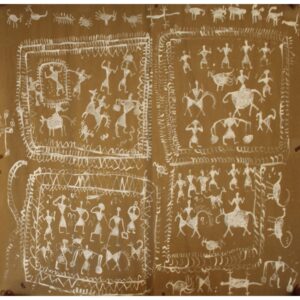Much of the art from these Tribal villages in Jharkhand are religio-cultural, that is, they have fixed motifs symbolizing certain specific social situations. The Khovar art depicts the socio-religious tradition of preparing a marriage room. The Khovar is the decorated nuptial room in Tribal tradition. The decoration is done by the bride’s mother and aunts. The custom of Khovar decoration is carried out among the Tribal groups of Oraon, Santhal and Munda in Hazaribagh. The Sohrai is the art of the harvest festival, and celebrates the plough agriculture done by cattle as well as the domestication of the cow. The mandalas to welcome the cattle back from the jungle are made from rice flour and milk in a kind of gruel which when dried on the sparse brown earth is brilliant white. The mandalas are in the form of hoof-prints, and sacred dots of vermillion bindu are put at line junctions. The women’s role in the festival is crucial, and points back to an ancient matriarchal society.


Khovar Painting
In the Tribal villages of Hazaribagh and its adjoining districts in the Indian state of Jharkhand, mud homes of Adivasis, are adorned with bold, figurative murals. There are two major art forms — Sohrai and Khovar, based on the harvest and marriage seasons. A dozen major Mesolithic rock-art sites in this area suggest a lengthy continuity of mural art there. These paintings are considered to bring good luck.
Khovar art was traditionally for decorating the marriage chamber of the bride and groom, and it usually depicts the animals and plants of neighbouring forests and valleys. The name Khovar is derived from two words: kho or koh (meaning: a cave) and var (meaning: husband). Symbolizing fertility, the mural-making takes place each spring during the marriage season.
The marriage season runs from January until the onset of the monsoons in June. It is in these months that Khovar designs are painted by the mother of the bride and other women of the villages as part of their traditional matrimonial ritual, where the marriage rites are performed and the newly-wed couple will sleep. This special area of the house is painted and decorated. Mothers pass on to daughters down countless generations the skills and motifs to create murals.
Jharkhand’s Sohrai Khovar painting was given the Geographical Indication (GI) tag on by the Geographical Indications Registry headquartered in Chennai. (courtesy: Indrosphere)
Dimension: 47X58 Inches
Medium: Clay and Charcoal on Canvas
Additional information
| Weight | |
|---|---|
| Dimensions | 47X58 Inches |
| Medium | Clay and Charcoal on Canvas |
| Provenance | Hazaribagh |




